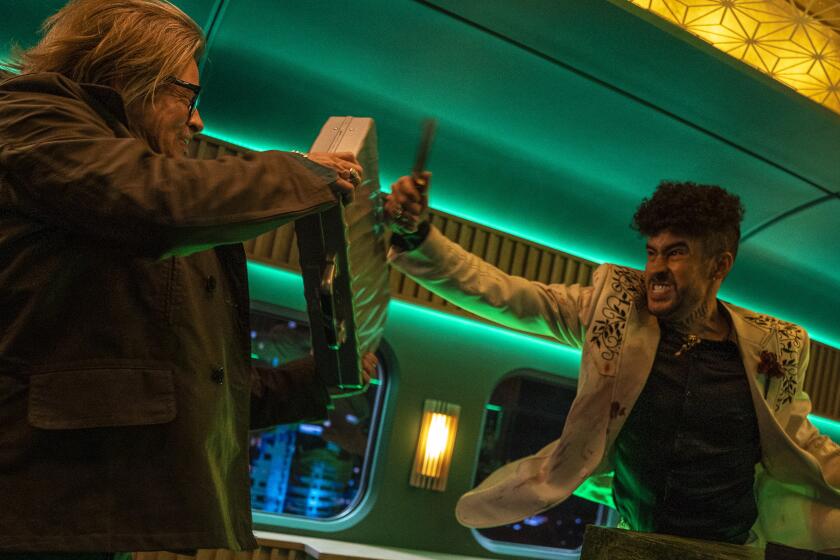Andrew Koji almost gave up on acting. Now the ‘Bullet Train’ and ‘Warrior’ star is leaving his mark
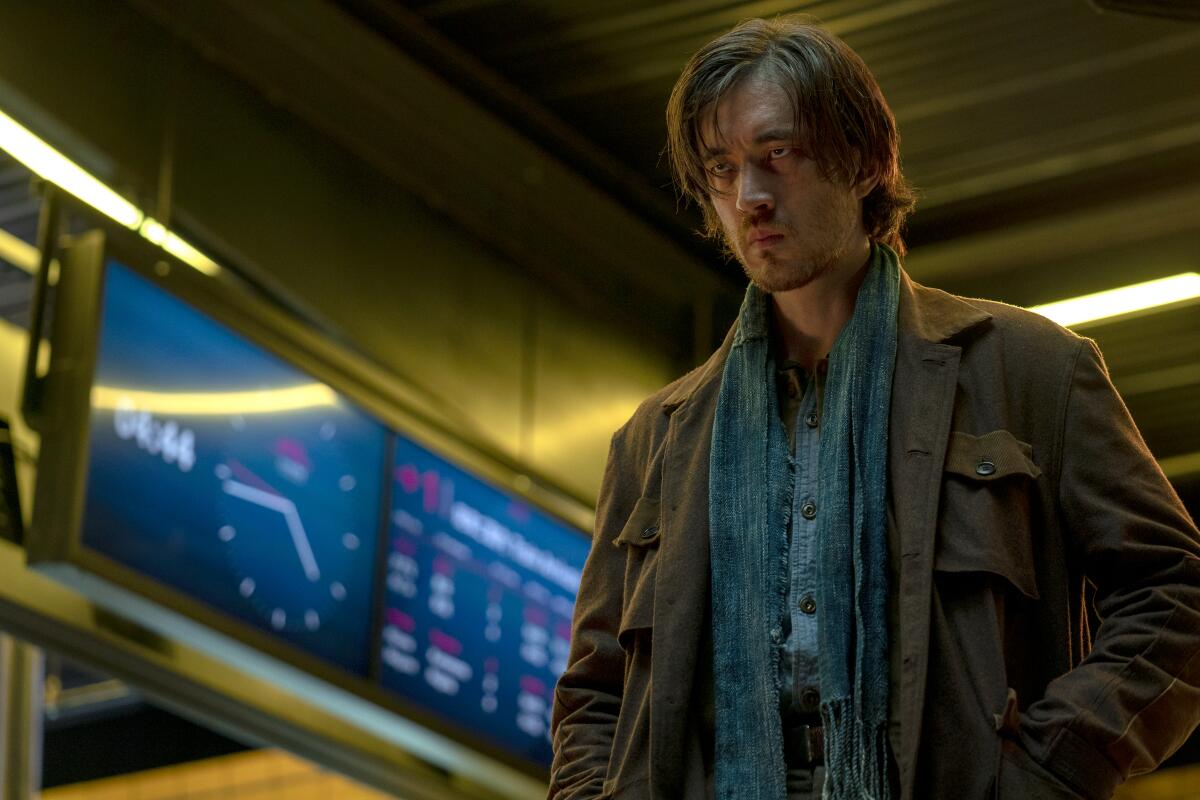
- Share via
It’s evening in Cape Town, South Africa, as Andrew Koji peers into his video chat screen after a long day of work on the set of his HBO Max action drama series “Warrior.” Upbeat nevertheless, the British actor catches a glimpse of himself, nearly does a double take and laughs. “I’ve got a scar on my head. Can you see that?”
The fresh gash above his eye appears to be a stray bit of special effects makeup, the kind of blow Koji, 34, has doled out with ferocity for two seasons on “Warrior” as the soul-searching fighter Ah Sahm, who steps off the boat in 1870s San Francisco into a tinderbox of swirling tensions among the Chinese Tongs, Irish mobsters, crooked police and even shiftier politicians. Only it’s not just real, it’s self-inflicted.
While stealing moments to train for an upcoming nunchaku scene — the signature weapon of martial arts legend Bruce Lee, whose writings inspired the project — Koji accidentally smacked himself in the head, he admits. Still, he’s happy with the progress. “It’s going OK,” he says with a grin, “but it still needs some work.”
Life has been a whirlwind since the groundbreaking Asian-led series catapulted him from struggling actor to series lead overnight five years ago, but Koji, clear-eyed and candid, is trying to remain centered in the midst of it all.
Sony Pictures’ ‘Bullet Train,’ starring Brad Pitt, Sandra Bullock and Bad Bunny, opened atop the domestic box office, while ‘Nope’ cruised toward the $100-million mark.
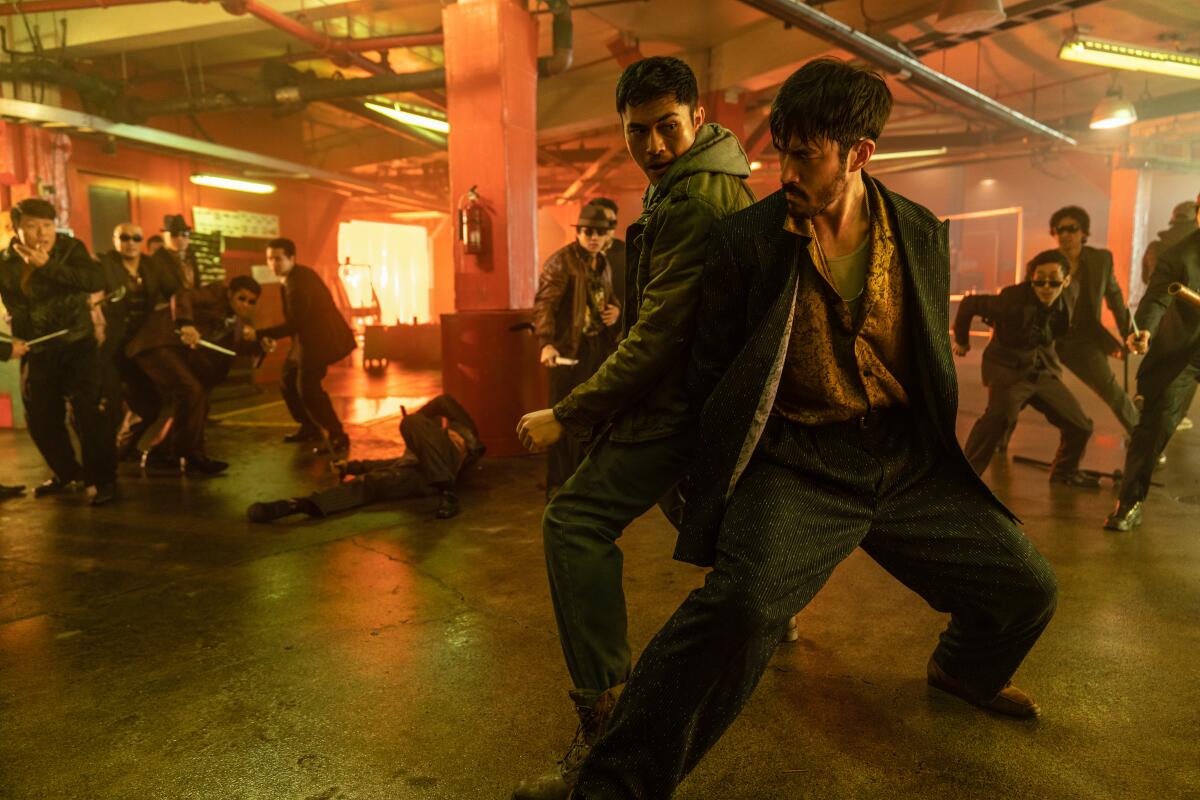
Landing swiftly on Hollywood’s radar, he brought zest to the role of Storm Shadow in Paramount Pictures’ 2021 actioner “Snake Eyes: G.I. Joe Origins” before scoring a role opposite Brad Pitt, Hiroyuki Sanada and Joey King in the Sony action-comedy “Bullet Train,” in theaters now, in which international assassins collide aboard the famed Shinkansen in a neon-lighted, heightened Japan.
As Kimura, the Tokyo criminal whose desperation to avenge his son sets the story’s events in motion, he lends gravitas to its otherwise cartoonish violence. “For me he’s a guy who is on the verge of losing it,” says Koji, who compares Kimura to Nicolas Cage’s despondent protagonist in “Leaving Las Vegas.” “He’s an alcoholic and he’s got nothing left.”
Born and raised in Surrey, England, to a Japanese father and English mother, Koji fell in love with film at an early age and found both catharsis and calling in acting — “the first thing that felt, in a way, effortless,” he says. Through storytelling he also found a way to process his own feelings of displacement and frustration, partly compounded by the racism he faced over his mixed ethnicity growing up in England.
As a teenager he moved to Thailand and Japan, trying to start his career, but felt like an outsider there too. So he returned home to pursue acting and made his own short films, even landing a gig stunt doubling for Sung Kang on “Fast & Furious 6,” directed by his future “Warrior” executive producer Justin Lin. But as in Hollywood, the close-mindedness of the U.K. entertainment industry kept doors maddeningly shut.
“There were no Asian roles in England,” he says. “I grew up in Britain but I was treated differently. I’m half-white but [in] this industry, you’re ‘Asian.’ We all go into the same box. It’s limiting.” By 2017 he was all but ready to give up when, at his mother’s urging, he auditioned for and landed the life-changing “Warrior” role. Now, Koji’s upcoming films include “Seneca — On the Creation of Earthquakes” with John Malkovich and the action thriller “Boy Kills World.”
Chatting over Zoom about how his experiences shaped the artist he wants to be, Koji also discussed his plans to write and direct, aiming to open the door wider for more inclusive voices, starting with a sci-fi conspiracy thriller project he developed and started pitching. “I want to do what Idris Elba did with ‘Luther,’ but for Asian representation,” says Koji. “Because I’m not going to go to my deathbed seeing [the industry] the same way as I left it.”
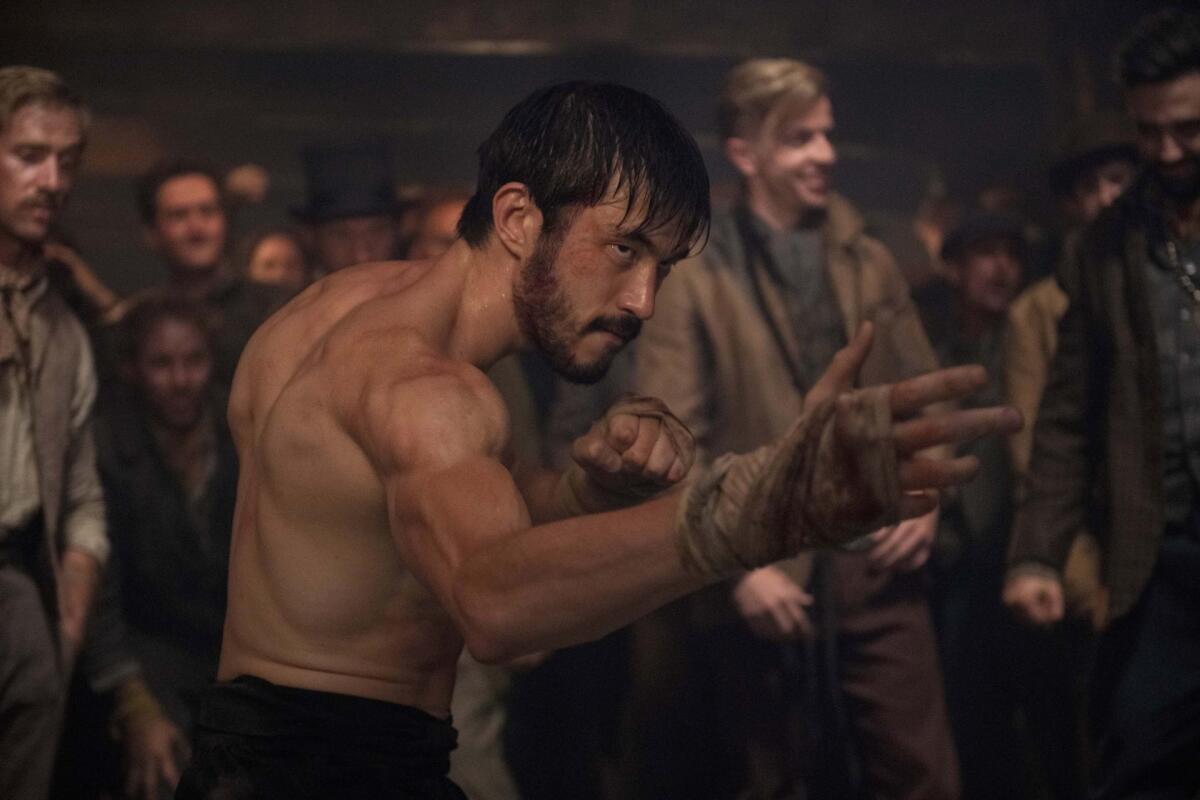
Like many folks of Asian descent in the U.S., U.K. and elsewhere, you’ve described a feeling of being between cultures and identities growing up. How do you look back on that now?
I grew up in England. I definitely wasn’t in touch with my Asian roots; I was pushing that away. I was the only Asian boy in school and that wasn’t perceived as a good thing. “Jackie Chan,” [mocking noises], that was all used against us, wasn’t it? It’s only the last couple years that I’ve started to really find pride in my Japanese roots and culture. For a while I had a psychological block; I went to go live in Japan and I didn’t feel at home there either. I was still an outsider, or treated as a bit different.
And how did those experiences shift as you went into acting?
It’s very strange, because I went to acting school and studied and trained, and while you’re there you’re just a human being. Good teachers are looking at your tool kit, your artistry. As soon as you come into the industry, they treat me like, “What box do I fit you in?” I want to try to help change representation [in England].
You wrote and starred in a 2017 short film called “Finding Akira,” playing an actor auditioning for a live-action “Akira” movie — only to have your Asianness scrutinized by the non-Asian casting agents and filmmakers. It speaks so acutely to how Hollywood operates.
Thank you! I want make my own stuff more. That was during the days when I had nothing. I hadn’t broken out yet. With “Finding Akira” I never thought I’d have a career in Hollywood and I was like, I’m going to f— take them down, that will be my contribution.
And now that you’ve broken in, can you do it from the inside?
That’s the plan.
[Warning: The video below contains profanity.]

Why do you think you gravitated toward acting and storytelling in the first place?
I was a very quiet kid up until my teenage years, when I became very troubled. That kept going on until the early 20s, the turmoil inside me. Maybe it was partly fed by the identity issues of, who am I, what am I? I look back now and all of this fed into that. And I think the one escape that I had from that was films.
I always made films when I was a kid. I think it was my only way that I could find catharsis and release, through creativity. It was the first time in my life I felt I could express myself. When I was a very quiet, shy, insular person, I saw films and great performances which moved me, really deeply and profoundly. I felt this was a worthwhile pursuit if I can feel less alone — if I can feel like there are other people going through the same problems I have — from watching a film. Then I went to acting school and somehow all my built up years of turmoil came out. [I realized] we can go through this pain and this trouble and these things can be cathartic to release, and also help other people. I can do what they’ve done for me.
What were some of the performances that moved and inspired you?
Two actors whose work I became fascinated with early on and I think I saw a bit of myself in were Heath Ledger — he was a very quiet, expressive, artistic troubled soul and I found his work fascinating — and I was watching so much of Philip Seymour Hoffman’s work.
Before landing your big break, you actually did have a Hollywood credit on your resume, stunt doubling for Sung Kang on “Fast & Furious 6” ...
I was in England, I’d been acting for about five or six years by that point and I didn’t have any money. A friend of mine called me up and said, “Do you want to do an action extras job for this Hollywood film?” I had no idea what it was. Drove down in my banged up Hyundai and it was a “Fast and Furious” movie. I was like, what the hell? They showed me this whole pre-viz and said, “You could pass for this guy’s double. Do you reckon you could do that?” I was like ... yeah, I could. So for about three months I was working on that, and made more money than I ever made in my life to that point.
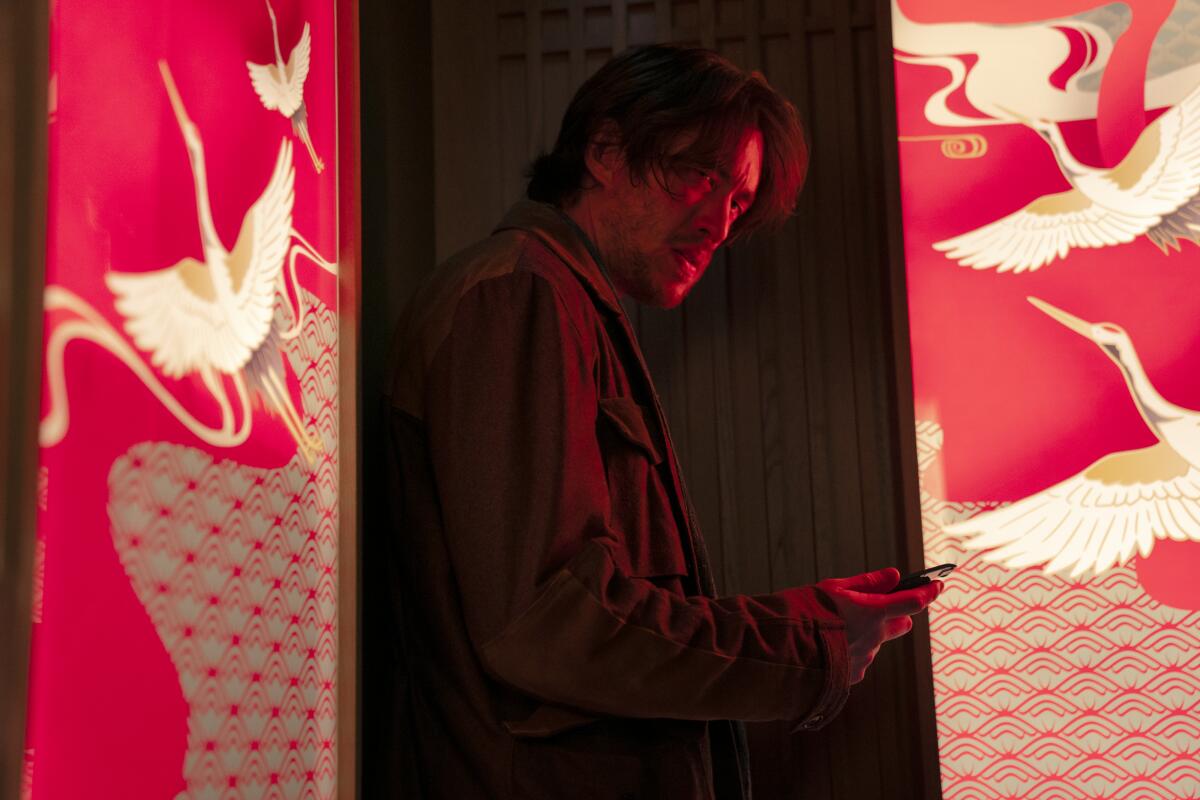
After “Snake Eyes,” “Bullet Train” is the second big studio film you’ve been cast in after breaking out with “Warrior.” What were you seeking career-wise when this role came along, and what made it enticing to play?
When I first got it I thought the script was really fun. There are some bits of Kimura which were really fascinating to me. He was an alcoholic and throughout the time on the train, this is the longest time he hasn’t drunk — it’s like a detox. With this tormented character, I thought ... I can play the role and say goodbye to those demons. It was almost while we were on set that it started to become this comedy. Then a lot of the cast was encouraged to do comedy, but Hiroyuki [Sanada] and I were encouraged to stay dramatic.
At the same time this was all around COVID, so I didn’t think I would work again. I was like, “My career is done after this!” “Warrior” had just been canceled as well. I was just like, “Cool, this is a bonus round. My swan song. See you later!” And then I was like, “You know what? I’m lucky I happen to be having this experience.” I think Kimura did have a lot more of a presence originally in this film, but as things shifted and changed I was just like, “I’m happy to be here, and to be alive. Who knows if this is still going to come out? Because the world might be ending.”
As someone of Japanese descent who actually lived in Tokyo, how did you feel about making a studio movie set in Japan, made by and starring mostly non-Asian creatives on a soundstage in Los Angeles?
I thought we were going to go to Japan up until while we were filming. I think they were playing with the idea of it and I think it was because of COVID that they were like, let’s just do it here. At the same time, I know there is some controversy about representation [in the movie]. When I was on the set, I thought, they have done research; even though a lot of it was heightened, I’ve been on the Shinkansen before and those details were accurate. Obviously I haven’t seen it yet. I know there’s not a racist bone in any of their bodies in the cast. The adaptation aspect, I was like, “You know what, it’s fine.” That was my take at the time.
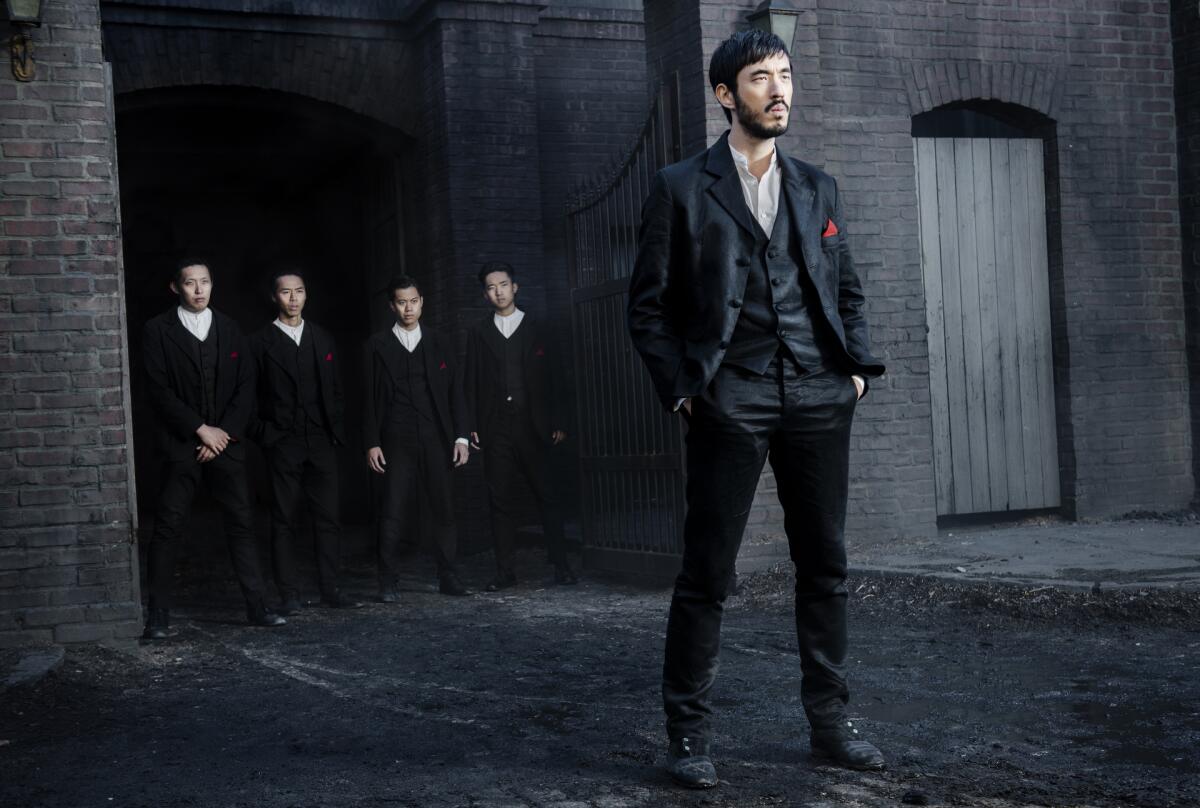
It was while you were in L.A. making “Bullet Train” that “Warrior” was saved from cancellation. How did you find out?
It was toward the end of the shoot. I got a phone call from [showrunner] Jonathan Tropper. He said, “Would you want to come back?” I said, yeah man — but what does that mean? “Well, if you want to come back, we’ll come back.” I was like, OK. Yeah!
By that time you’d already said goodbye to Ah Sahm. Now you’re back on the “Warrior” set. What does it mean to you to be able to continue it now?
You know how fragile this whole acting career is, how fickle. I thought, OK, that was my go at a Hollywood acting career. “Warrior” did two seasons, I worked my ass off for that, and it got canceled. I’ve got [“Snake Eyes”] coming out so at least I did a film, even though it wasn’t going to do well. I’d let go of it completely. I did my best. Even now sometimes I think about changing careers. If I do, realistically, it will be to directing and producing. I want to help others, because sometimes you don’t have that position of power as an actor, to help create the change that I want to see.
“Warrior” is a show that is important for Bruce Lee’s legacy, as well as changing my life, and also for Asian representation. For a lot of people it really means something. So as exhausting as it is, and as tough as the shoot can be on my body and my mental space, I had to come back. I have to finish this. I hardly ever see an Asian show that finishes on its own terms. I think it would mean something if we can go from start to finish on our terms, rather than be canceled. We can say that it can be done.
More than four decades ago, Hollywood told Bruce Lee it couldn’t be done.
More to Read
Only good movies
Get the Indie Focus newsletter, Mark Olsen's weekly guide to the world of cinema.
You may occasionally receive promotional content from the Los Angeles Times.
